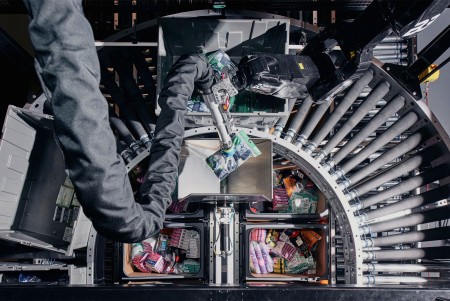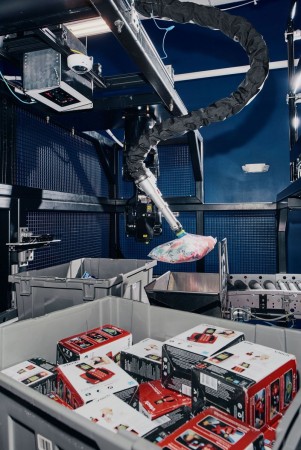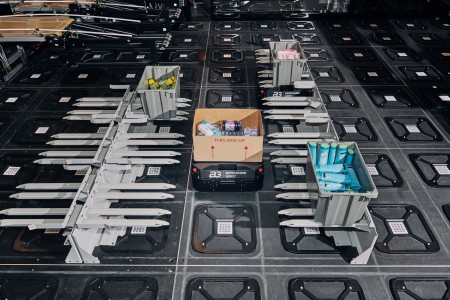
Robots do the job of human pickers at a Berkshire Grey lab. Photographer: Tony Luong for Bloomberg Businessweek
In an enormous space at an undisclosed U.S. location, a four-wheeled autonomous vehicle the size of a microwave oven rolls up to a robotic arm and stops suddenly. The arm swivels, inserts a probe into the vehicle’s plastic bin, and, with a whooshing sound, retrieves a box of Hamburger Helper. The arm drops the processed pasta-and-sauce concoction into a cardboard box for shipment, and another little robot car takes it away.
This system has been a closely guarded secret. But a few days after Thanksgiving, with shopping season under way, the robots’ creator, Boston startup Berkshire Grey Inc., gave a Bloomberg Businessweek reporter a peek, as dozens of little machines scurried around the vast warehouse.
Berkshire Grey built the system for a large retailer not named Amazon. The startup, founded in 2013, charges tens of millions of dollars for these installations, pitching them as a way for retailers to compete with the ruthless efficiency of Amazon.com Inc. Jeff Bezos’ company has trained customers to say, “I want exactly what I want, and I want it now. And, oh, by the way, I expect the shipping to be free,” says Tom Wagner, Berkshire Grey’s chief executive officer.

Suction cups and air compression help Berkshire Grey’s robotic arm better approximate the versatility of the human hand.
Photographer: Tony Luong for Bloomberg Businessweek
The likes of Walmart, Target, and Best Buy have little choice but to reach more customers online. On Black Friday, online retail revenue rose 24 percent from the previous year, while customer traffic in stores fell about 2 percent, according to Adobe Analytics and ShopperTrak, which monitor online stores and physical ones, respectively. Amazon said this year’s Cyber Monday was the biggest shopping day in company history.
Wagner, previously chief technology officer for vacuum maker IRobot Corp., got the idea for Berkshire Grey in 2012 after visiting a retail distribution center. Amazon had just paid $775 million for Kiva Systems Inc., a maker of robots that ferry shelves around warehouses, and other retailers didn’t seem to recognize that the bots represented a serious competitive advantage in the notoriously brutal delivery business. “It’s hugely labor-intensive,” Wagner says of the industry. “And the jobs themselves are not highly sought after.”
That’s an understatement. Working in a retail warehouse is so physically demanding and the wages so low that even in an era of automation, companies routinely struggle to find enough workers and face almost continual criticism about low wages and exploitative, unsafe environments. On Black Friday, Amazon workers in Germany, Spain, and Italy walked out during their shifts to protest their conditions.
Wagner says Berkshire Grey’s system goes beyond Amazon’s robot helpers. He’s using robots to pick, pack, and ship most items, typically without any human contact. The small robots, known as FlexBots, work like little self-driving cars, pulling up under shelves and nudging plastic bins full of goods onto their platforms. The bots then bring the bins to robotic arms that grab items and place them in shipping boxes, which are then sorted by another set of robotic arms and conveyor belts.

Berkshire Grey’s FlexBots remove boxes from shelves.
Photographer: Tony Luong for Bloomberg Businessweek
Amazon and other retailers still use humans to pick up items, because replicating the human hand, which can just as easily grab a lightbulb as it can a pack of AA batteries, is one of the toughest problems in robotics. The key technical breakthrough was suction cups, says Matt Mason, Berkshire Grey’s chief scientist and a Carnegie Mellon University computer science professor who specializes in grip.
Mason and Berkshire Grey’s 100 employees, spread across a Lexington, Mass., headquarters and a Pittsburgh research and development lab, designed a system that uses cameras connected to artificial intelligence software to scan and identify each item, verifying that it belongs in the shipping queue and determining where to grab it. The software directs a robotic arm with a flexible cup on the end and fires an air compressor to create a vacuum to lift the item off the FlexBot’s tray and drop it in a box for shipping.
Berkshire Grey says it’s signed up several large retail and shipping companies and that its customers have reduced the labor costs of picking items by as much as 80 percent. Humans still need to handle goods that are fragile or weigh more than 5 pounds, says Wagner, though he adds that the company could design systems to handle heavier loads.
He won’t win the robotic arms race that easily. In May, Kroger Co. paid $248 million for a minority stake in the U.K.-based grocer Ocado, which is developing fully automated warehouses. And in October, tech news site the Information reported that Amazon was developing its own vacuum gripper. But Wagner doesn’t necessarily have to beat Amazon. Most retailers are so far behind that even keeping pace would be a victory. —With Spencer Soper